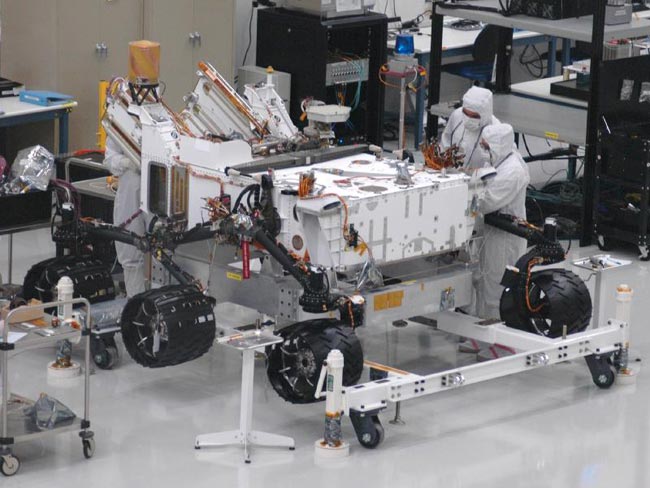Future Mars Rover Gets New Set of Wheels

NASA's nextMars rover just got a new set of wheels and an innovative suspensionsystem inpreparation for its journey to the red planet.
The MarsScience Laboratory Curiosity,a robot car is scheduled to launch in 2011 and reach Mars soil inAugust 2012. Eachof its six new wheels is about 20 inches (about half a meter) indiameter.
Theambitious rover is designed to collect samples and conduct tests onrocks acrossthe Martian surface in order to dissect the planet's geological history.
Unlike pastrovers, which set down on Mars with landers, the new rover's design isbuilt toallow Curiosityto touch down on the Martian surface directly. Though itpossesses the samenumber of wheels (six) and the rocker-bogie suspension system ofprevious NASAMars rovers like Spirit, Opportunity and Sojourner, Curiosity'smobility systemis uniquely capable of absorbing the shock of a rocket-powered landing.
"Inthis case the first thing to touch the ground is not the petal of thelanderbut the wheels of the rover itself," said GuyWebster, a spokesperson for NASA's Jet PropulsionLaboratory (JPL) inPasadena, Calif., which is building the rover.
Previousrovers were encased in folded-up petals that were packed inside airbags forthe journey to Mars, Webster said. Upon landing, these air bags bouncedon thesurface of Mars, and then their panels opened up, exposing the wheels. [Bestand worst Mars landings.]
"It isthe first time we've done this before, but we do intend to use it inthe futureas well," Curiosity mission leader Michael Watkins of JPL toldSPACE.com. "It'sa more mass-efficient way to land. We don't have to carry a separateheavypallet below the rover, and it also weighs less."
Breaking space news, the latest updates on rocket launches, skywatching events and more!
The lowerpackaging mass frees up more room for the rover and its scienceequipment. Withoutits novel landing system, the 1,980 pounds (900 kg) rover would havehad to setaside a few hundred kilograms of its payload to house the airbag andlandingplatform, Watkins said.
Curiosity's sciencegear includes a laser that will be used to vaporize rocksfrom a distanceand an instrument that can test for organic compounds that could offerhopethat life may have once existed on the planet.
- Gallery? Latest Mars Photos FromSpirit and Opportunity
- TheBest and Worst Martian Landings
- Video:Building Curiosity ? Mars Science Lab Unveiled
Zoe Macintosh is a science writer who covered human spaceflight, astronomy and science for Space.com in 2010. She also covered general science for Space.com's sister site Live Science. Zoe studied English literature and physics at Smith College, where she also wrote for the Smith Sophian. Her work has also appeared in the National Association of Science Writers website.
